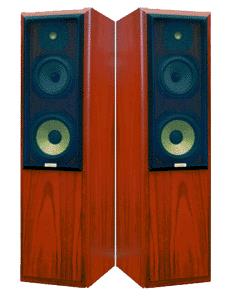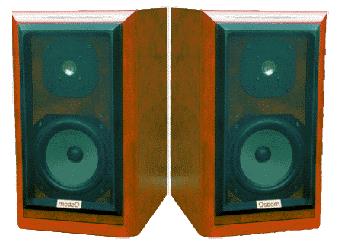Product Review - Osborn Eclipse Speakers /
Osborn Titan Speakers - August, 1996 - Updated September, 2000
By John E. Johnson, Jr.
![]()
 |
 |
| Osborn Speakers | USA: Community Audio | |
| 17 Hammersley Court | Philadelphia, Pennsylvania | |
| Taylors Lakes | ||
| Victoria, 3038 | ||
| Australia | ||
| Phone: 613-9390-1564 Fax: 613-9390-4775 | ||
| http://www.osbornloudspeakers.com.au/ | E-Mail: [email protected]. |
Osborn Speakers; Osborn Eclipse; Floor standing; Three way vented; One 1 1/4" fiber glass dome tweeter, one 7" neoflex mid-range, one 8" polyglass woofer; Frequency response 35 Hz - 18 kHz plus or minus 3 dB; Crossover frequencies 400 Hz and 3.5 kHz second order; Sensitivity 91 dB/w/m; Power handling 120 w rms per channel; Nominal impedance 8 Ohms (min 5.8 Ohms); Size 43"H x 11 3/4"W x 17"D; Weight 92 pounds each; $3,500/pair (Bubinga wood); Osborn Titan; Monitor; Two way vented; One 1 1/4" Kevlar dome tweeter, one 7" polyglass mid-bass driver; Frequency response 40 Hz - 19 kHz plus or minus 2 dB; Crossover frequency 3.7 kHz first order; Sensitivity 89 dB/w/m; Power handling 70 w rms per channel; Nominal impedance 8 Ohms (4 Ohms min); Size 18"H x 10 1/2"W x 14"D; Weight 56 pounds each; $2,500/pair (Bubinga wood)
Gee, I'm glad I did not have to lift these out of the packing box. They are massive . . . and extraordinarily beautiful. Some recent Australian speakers we reviewed were veneered in Jarrah, and the Osborns arrived finished in Bubinga wood. I had never seen either of these woods until we began reviewing Australian speakers. You fellows really know how to build cabinets! The close up photo does not do justice to the burl on the Bubinga, but it will give you some idea anyway. Such wood finishes always add a substantial amount to the price, but this kind of beauty is really worth it. The basic construction is 1 1/4" MDF.
The Osborns are both rear ported designs, with two sets of gold plated binding posts for bi-wiring and bi-amping. Greg Osborn states that bi-wiring provides the best sound for his speakers, so we removed the jumper plates, and tested them in a bi-wire configuration (Nordost Super Flatline). Associated equipment included the McCormack CD transport and DAC, NAD 208 MOSFET Power Amplifier, Carver Silver 9t Power Amplifiers, Nordost, Kimber, and AudioQuest cables.
I will be frank with you. At first, I did not like these speakers, at least the Eclipses. I felt they were too heavy in the mid-range. Even after extensive playing, they still had a very full bodied sound, and a bit of a laid back upper end. However, I realized that I had conditioned myself to a sound that had a laid back mid, which is simply my preference. So, I asked others in the lab to listen to the Osborns, single blind, comparing them to several other speakers. Most (2 out of 3) preferred the Osborns, citing their smooth top end, and extraordinary ability to convey a sense of presence (that's the mid-range). The forward mid-range is less apparent on the Titans, but still noticeable . . . to me. In any case, however, the bass is astonishing. I was worried that the small magnet structure on the Eclipse bass driver would allow the speakers to be easily overdriven. Not so! The Eclipse was powerful, deep, and responsive at thunderous SPL. The Titans were also capable of being driven loudly, but maintaining their sonic composure. This has to do, not with just the drivers, but the damping and bracing of the enclosures. Of course, the bass is more intense with the Eclipses, but the Titans deliver amazing bass for their size. I liked the Eclipses best with the tweeters at ear height, and the speakers toed inward so they were facing almost directly at me when I was sitting about 8 feet away. Standing up produced a noticeable tonal change, probably due to the phase plug on the mid-range driver. Moving around did not change the tonality so much with the Titans.
Frequency Response Test Results (These data represent tests in a real room with furniture, not anechoic tests or simulations, and thus, may be somewhat different than you might experience in your own listening room of other dimensions and contents):
Eclipse, left channel, grille on, 1 meter, on axis:
20 Hz 76.4 dB 500 Hz 59.0 dB 25 Hz 80.2 dB 800 Hz 80.0 dB 31.5 Hz 86.4 dB 1 kHz 80.4 dB 40 Hz 81.3 dB 2.5 kHz 86.1 dB 50 Hz 85.1 dB 5 kHz 89.9 dB 63 Hz 98.4 dB 8 kHz 89.9 dB 80 Hz 97.7 dB 10 kHz 89.5 dB 100 Hz 89.8 dB 12.5 kHz 90.6 dB 125 Hz 83.6 dB 15 kHz 80.7 dB 160 Hz 81.4 dB 18 kHz 74.3 dB 200 Hz 88.0 dB
Eclipse, left channel, grille on, 13 feet, on axis:
20 Hz 82.5 dB 500 Hz 86.6 dB 25 Hz 86.3 dB 800 Hz 80.0 dB 31.5 Hz 95.9 dB 1 kHz 83.8 dB 40 Hz 84.6 dB 2.5 kHz 84.3 dB 50 Hz 82.3 dB 5 kHz 83.2 dB 63 Hz 95.7 dB 8 kHz 86.3 dB 80 Hz 98.6 dB 10 kHz 87.8 dB 100 Hz 83.4 dB 12.5 kHz 87.3 dB 125 Hz 88.6 dB 15 kHz 83.0 dB 160 Hz 80.0 dB 18 kHz 72.4 dB 200 Hz 89.9 dB
Titan, left channel, grille on, 1 meter, on axis:
20 Hz 65.2 dB 500 Hz 84.9 dB 25 Hz 67.3 dB 800 Hz 80.9 dB 31.5 Hz 71.9 dB 1 kHz 82.4 dB 40 Hz 69.4 dB 2.5 kHz 85.0 dB 50 Hz 72.8 dB 5 kHz 88.7 dB 63 Hz 86.9 dB 8 kHz 85.1 dB 80 Hz 84.6 dB 10 kHz 87.1 dB 100 Hz 78.4 dB 12.5 kHz 89.5 dB 125 Hz 74.0 dB 15 kHz 85.4 dB 160 Hz 76.6 dB 18 kHz 79.7 dB 200 Hz 85.4 dB
Titan, left channel, grille on, 13 feet, on axis:
20 Hz 66.1 dB 500 Hz 72.7 dB 25 Hz 68.9 dB 800 Hz 72.3 dB 31.5 Hz 76.6 dB 1 kHz 79.9 dB 40 Hz 66.3 dB 2.5 kHz 76.2 dB 50 Hz 65.7 dB 5 kHz 77.6 dB 63 Hz 79.3 dB 8 kHz 66.0 dB 80 Hz 81.1 dB 10 kHz 79.1 dB 100 Hz 68.2 dB 12.5 kHz 71.5 dB 125 Hz 72.6 dB 15 kHz 73.2 dB 160 Hz 71.7 dB 18 kHz 71.7 dB 200 Hz 81.3 dB
We could not hear any harmonics generated from sine waves at very low frequencies from either the Eclipse or the Titan. Both speakers produce usable sound at 25 Hz (the Eclipse down to 20 Hz), and the tone was among the cleanest we have ever heard. In fact, this type of bass performance comes close to a servo feedback subwoofer! Superbly designed enclosures are the only way to achieve this, and Greg Osborn has done a fine job. The slightly laid back high end is apparent from the frequency response tests, so my ears were correct in their assessment. A little EQ can bring the sound to my own preferences, but for the majority of listeners, they will perform exquisitely as is.
John E. Johnson, Jr.
Editor
Update - September, 2000
Recently, Greg Osborn sent me some new drivers and crossover network boards to install into my original set of Eclipse speakers. The replacement units consisted of Focal mid-range drivers (now Polyglass instead of acrylic, and with 35% larger magnet) and Focal woofers (Focal makes extremely high quality drivers). The tweeters were not replaced. The new woofer crossover network boards had larger air inductors and higher quality capacitors. Resistors for the tweeters and mid-range drivers on the existing crossovers were also replaced.
Colin Miller installed them for me by removing the drivers from the front of the enclosure and unscrewing the crossovers, followed by unsoldering and re-soldering the connecting wires to the drivers and crossovers.
The sound of the new drivers and crossovers is much different than the originals. Bass is now tighter, the treble clearer, and the forward mid-range is gone, having been replaced with a much more balanced mid.
The improved sound quality, coupled with the still awesome enclosure finishing, keeps the Osborn Eclipses a remarkable speaker in its price class. Spouses everywhere will approve of their beauty, and husbands will delight in their power and clarity.
- John E. Johnson, Jr. -
![]()
© Copyright 1995 - 2000 Secrets of Home Theater
& High Fidelity
Return to Table of Contents for this Issue.

